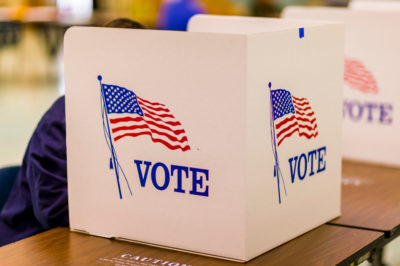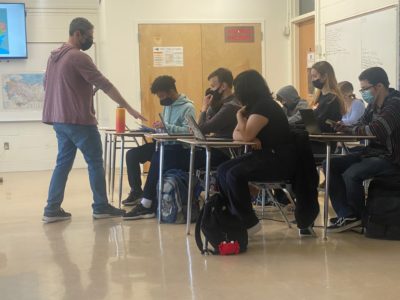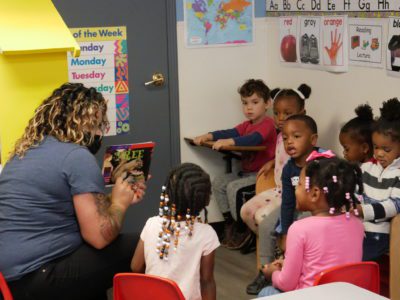
Share this story
- In-person early voting has kicked off in North Carolina. Find out what candidates say about challenges facing schools and families. #nced #ncpol
- Candidates for office received questionnaires from @NCEarlyEdCo and @theNCforum and answered questions on child care, teacher shortages, and school support personnel. #nced #ncpol
|
|
In-person early voting has started in North Carolina, and runs through Saturday, Nov. 5 — three days before Election Day.
The results of this election clearly will shape policies that affect children and schools. Some of the candidates running for state and federal office have shared their stances and ideas on education — from affordable child care to teacher compensation and diversity to infrastructure needs — in questionnaires from two organizations.
The North Carolina Early Education Coalition sent a four-question survey on issues facing early care and education, both to candidates running for the state legislature and to represent the state in Congress. The Public School Forum of North Carolina distributed a six-question survey only to state legislative candidates on addressing K-12 education issues.
Six candidates for Congress and 39 state legislative candidates responded to the early childhood survey. Find their responses here. And you can find answers from the 129 General Assembly candidates who have responded to the K-12 survey on this map by selecting either “House” or “Senate,” and then scrolling over each county.
When it came to early care and education, candidates mentioned more funding for child care subsidy, higher compensation for teachers, and expanding the Child Tax Credit. Some expressed the need for flexibility and parental control.
Sign up for Early Bird, our newsletter on all things early childhood.
“Many of our responses acknowledge the very difficult challenges that are facing families and early educators, and it seems like this sort of bipartisan response shows that there still is bipartisan interest and support for child care and many other early childhood issues,” said Jenna Nelson, executive director of the coalition.
Here are the questions the coalition asked:
What are your views on the needs of young children (prenatal to age 5) and what specific
steps would you take to address these needs?What steps would you take to ensure that children birth to age five have access to high-quality and affordable early learning programs?
What steps would you take to stabilize and sustain North Carolina’s early education system and child care workforce as we approach the end of the federal child care relief funding?
Candidates’ responses to the K-12 survey had some common threads, Lauren Fox, the forum’s senior director of policy and research, said in an email, including “somewhat consistent support for increasing teacher pay to address teacher attrition and pipeline issues.” But as far as how to approach and what “competitive pay” meant, candidates’ opinions varied.
Fox said most expressed support for more access to school support personnel like psychologists, counselors, nurses, and social workers. Some said they supported fully funding recommended ratios, while others said schools should partner with private entities for services.
Many responded in support of funding the comprehensive remedial Leandro plan. Some called for more funding for school choice options. Others said they supported increasing educator preparation access at HBCUs to train and hire more teachers of color. “A small number of respondents,” Fox said, “expressed concern over curriculum that addresses issues of race, sex, and mental health.”
These are the questions the forum asked:
According to a recent national poll of teachers, 55 percent of respondents indicated that they are more likely to leave their position sooner than expected due to stress experienced from the COVID-19 pandemic (NEA, 2022). What policies would you support while in office to promote the recruitment and retention of a diverse teacher workforce?
Teacher pay in North Carolina ranks 33rd in the nation, and beginning teachers start out their careers with a base salary of just over $35,000. As a point of comparison, Mississippi just raised their starting teacher pay from $37,123 to $41,638, putting Mississippi above the southeastern and national averages. As a member of the North Carolina General Assembly, what would you do to ensure the teaching profession is an attractive and sustainable career path for North Carolinians?
In the 2020-21 school year, the average NC school nurse to student ratio was 1:890, while the national recommended ratio is 1 per school. Additionally, the average ratio of school counselors in NC in 2019 was 1:367 compared to the recommended ratio of 1:250, and the average ratio of social workers in 2019 was 1:1,427 compared to the recommended ratio of 1:250. Do you think our schools and students should have access to school psychologists, counselors, social workers, and school nurses? How will you ensure this access?
North Carolina ranked 40th in the nation in 2019-20 in “public school current expenditures per student in average daily attendance,” also known as per-pupil funding (NEA, 2021). The Leandro Comprehensive Remedial Plan calls for robust investments in our schools to implement evidence-based interventions. These investments include high-quality well-prepared teachers, high-quality principals, early childhood education, post-secondary pathways, school support personnel like counselors and social workers, and accountability and finance systems that ensure our students have what they need. Given this, what are three top actions that the General Assembly can take to ensure our state meets its constitutional obligation to provide a sound basic education for every child?
It was recently estimated that our public schools have $13 billion in school infrastructure needs, resulting from growing student populations and aging school buildings. The last K-12 statewide school bond of $1.8 billion was passed 25 years ago, in 1996. In prior years, statewide school bonds were passed roughly every decade. How would you address school infrastructure needs, and how would you ensure the needs are addressed equitably and in sufficient amounts?
The demographics of our student population in North Carolina are shifting. Students of color comprise the majority (roughly 54%) of the 1.37 million students enrolled in the state’s traditional public schools. About forty-four percent of students are white. However, the teacher workforce is not representative of our student population—teachers of color comprise approximately 20% of the workforce. Data show that as compared to white students, students of color in North Carolina are under-represented in advanced and gifted courses, are less likely to be taught by experienced teachers, and receive higher rates of school suspensions for similar infractions (CREED, 2019). How would you address racial equity in our schools?
Recommended reading




